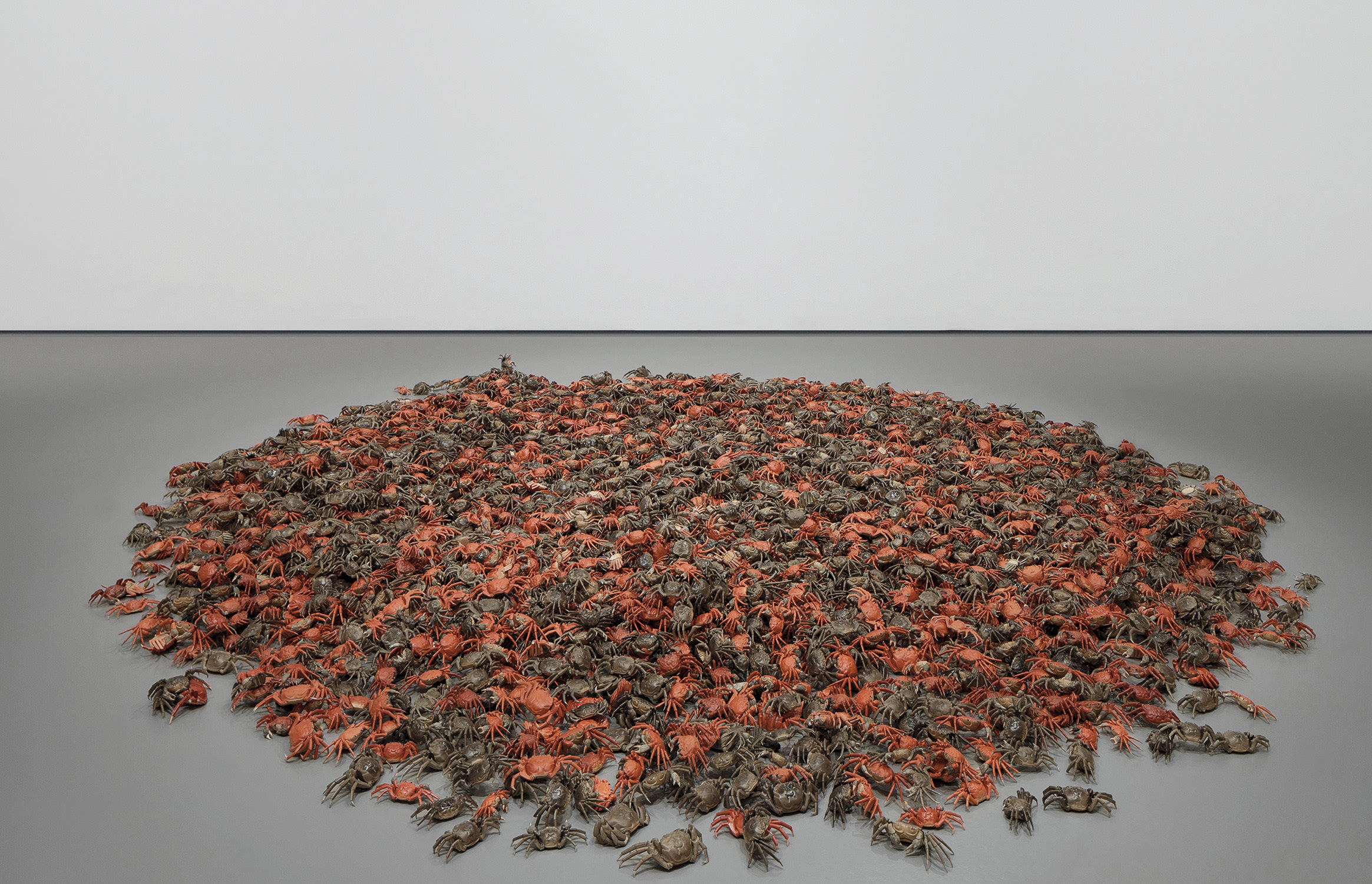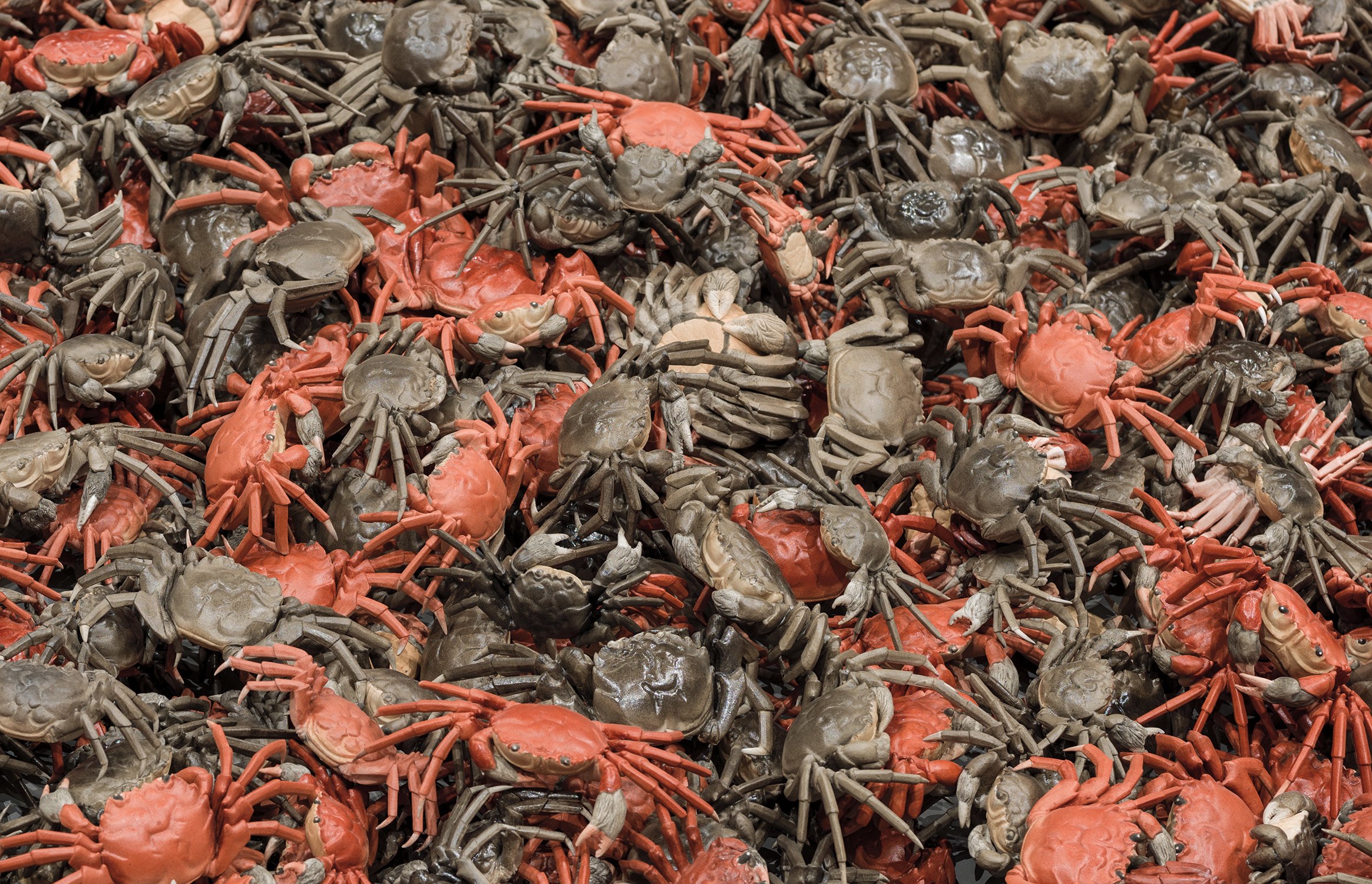



60
Ai Weiwei
He Xie
porcelain, in approximately 2,300 parts
dimensions variable
Executed in 2010.
Full-Cataloguing
Ai Weiwei’s He Xie, 2010, presents the viewer with 2,300 porcelain crabs, piled on one another and scattered on foreign ground. Usually nestled in corners of gallery spaces or placed centre stage in vacant museum rooms, the installation’s lifeless crustaceans are as though removed from their traditional habitat and thrown into an artificial spotlight, unsuspectedly becoming prey to any passing visitor’s scrutiny. While this random display of static figurines in artistic contexts may seem harmless and even humorous at first, one may easily infer, upon further reflection, the installation’s daunting political implications. In other words, and as often with Ai Weiwei’s works, apparent simplicity betrays plural meaning, while seemingly gentle surfaces readily uncover thorny foundations.
In the case of He Xie, the transformation of a species’ living environment into a space open for spectatorship symbolically refers to the methods of exposure utilised by China’s surveillance state. With increasingly powerful technologies enabling wider arenas for census and tighter control systems, access to online and offline resources have been limited, and individual freedoms have been restricted over time. In performing a pretend displacement of marine life, Ai Weiwei thus brings forth issues of privacy and human rights at large.
The sense of displacement entailed by the crabs’ dislocation furthermore bears lexical ramifications. He Xie, translating to either ‘harmony’ or its homophone ‘water crab’ in Chinese Mandarin, indeed possesses concealed undertones, brimming with political hues. Around the time of the present work’s creation, the expression ‘he xie’ was thrust beyond its literal meaning by internet users to designate online censorship in China, satirically subverting the government’s appropriated notion of ‘harmony’, instead giving it the face of a crab. Proliferating on forums as well as the rare accessible social platforms, crustacean iconography was thus extracted from its original semantic universe and propelled into political ground.
This practice of subversion is not unfamiliar to Ai Weiwei. In one of his more solemnly striking works, executed a year before the present installation, the Beijing-born artist spent a year looking into a political coverup involving poorly constructed schools which had succumbed to a natural disaster in Sichuan, 2008. Tens of thousands of young students were trapped underneath the weakened walls, culminating in an appalling death toll exceeding five thousand. Following Ai’s thorough inspection of this tragedy, the artist materialised a poignant piece entitled Remembering, consisting of 9,000 inflatable backpacks writing out the work’s title in Mandarin characters. The visual lightheartedness of Remembering, echoing the innocent colours of childhood, marks a stark contrast with the heavy reality of the corruption it denounces. The piece’s attachment to a specific event furthermore likens it to a memorial, and lends it resounding authority.
While Ai Weiwei’s prolific body of work touches upon various national political concerns, and extends at times to the international arena, the beating heart of all his pieces remains an unwavering and hopeful aspiration towards human rights; its beam of light is like an undetachable cover enveloping each new creative gesture.
In this perspective, the activist motivations behind Ai’s works always precede their form. While He Xie is a movable installation and Remembering was an ephemeral and site-specific architectural project, other works by the artist have flourished amidst distinctive genres: iconoclastic sculptures (Coca-Cola vases), dissident photographs (Study of Perspective) and critical films. As fellow artist and friend Olafur Eliasson once exclaimed, Ai’s ‘content can be translated into any form, any language. It could be a building, a film, a sound, a poem, a gust of wind’ (Olafur Eliasson, quoted in Ai Weiwei: Libero, exh. cat., Palazzo Strozzi, Florence, 2016, p. 78). In other words, Ai Weiwei’s art will adopt any form, so long its breath is political.
Countless artists over time have aligned with Ai Weiwei’s atemporal ideals of freedom and harmony, and expressed them in personal ways; few have descended the risky route of activism, which led the Chinese artist to detention in 2011.
An artist who has also addressed some of China’s post-Communist political tenets is Song Dong. In his 2005 installation Waste Not, the Beijing-born artist amassed a large collection of items his mother had kept through the years, arranging them under a house-like structure in an attempt to physically box her life, literally condensing the documents that witnessed its unfolding. The matter of hoarding that Waste Not addresses touches upon the anxieties of an older generation not having enough supplies to live on in Communist China, but is also reflective of a later and current phenomenon of mass-consumerism worldwide. While Ai Weiwei’s He Xie is coldly critical and sharply political, Song Dong’s Waste Not is warm, tackling politics at the surface only to go deeper into familial intimacy.
Maurizio Cattelan’s Frank and Jamie, on the other hand, bears a sardonically humorous tone. Portraying two eponymous policemen, scalps against the ground, standing upside down, the two-part sculpture sheds lights on the paradox of arbitrary authority. The viewer is acquainted with neither Frank nor Jamie, and yet is easily able to observe the policemen’s incapacity to enact reasonable power.
In the case of He Xie, the transformation of a species’ living environment into a space open for spectatorship symbolically refers to the methods of exposure utilised by China’s surveillance state. With increasingly powerful technologies enabling wider arenas for census and tighter control systems, access to online and offline resources have been limited, and individual freedoms have been restricted over time. In performing a pretend displacement of marine life, Ai Weiwei thus brings forth issues of privacy and human rights at large.
The sense of displacement entailed by the crabs’ dislocation furthermore bears lexical ramifications. He Xie, translating to either ‘harmony’ or its homophone ‘water crab’ in Chinese Mandarin, indeed possesses concealed undertones, brimming with political hues. Around the time of the present work’s creation, the expression ‘he xie’ was thrust beyond its literal meaning by internet users to designate online censorship in China, satirically subverting the government’s appropriated notion of ‘harmony’, instead giving it the face of a crab. Proliferating on forums as well as the rare accessible social platforms, crustacean iconography was thus extracted from its original semantic universe and propelled into political ground.
This practice of subversion is not unfamiliar to Ai Weiwei. In one of his more solemnly striking works, executed a year before the present installation, the Beijing-born artist spent a year looking into a political coverup involving poorly constructed schools which had succumbed to a natural disaster in Sichuan, 2008. Tens of thousands of young students were trapped underneath the weakened walls, culminating in an appalling death toll exceeding five thousand. Following Ai’s thorough inspection of this tragedy, the artist materialised a poignant piece entitled Remembering, consisting of 9,000 inflatable backpacks writing out the work’s title in Mandarin characters. The visual lightheartedness of Remembering, echoing the innocent colours of childhood, marks a stark contrast with the heavy reality of the corruption it denounces. The piece’s attachment to a specific event furthermore likens it to a memorial, and lends it resounding authority.
While Ai Weiwei’s prolific body of work touches upon various national political concerns, and extends at times to the international arena, the beating heart of all his pieces remains an unwavering and hopeful aspiration towards human rights; its beam of light is like an undetachable cover enveloping each new creative gesture.
In this perspective, the activist motivations behind Ai’s works always precede their form. While He Xie is a movable installation and Remembering was an ephemeral and site-specific architectural project, other works by the artist have flourished amidst distinctive genres: iconoclastic sculptures (Coca-Cola vases), dissident photographs (Study of Perspective) and critical films. As fellow artist and friend Olafur Eliasson once exclaimed, Ai’s ‘content can be translated into any form, any language. It could be a building, a film, a sound, a poem, a gust of wind’ (Olafur Eliasson, quoted in Ai Weiwei: Libero, exh. cat., Palazzo Strozzi, Florence, 2016, p. 78). In other words, Ai Weiwei’s art will adopt any form, so long its breath is political.
Countless artists over time have aligned with Ai Weiwei’s atemporal ideals of freedom and harmony, and expressed them in personal ways; few have descended the risky route of activism, which led the Chinese artist to detention in 2011.
An artist who has also addressed some of China’s post-Communist political tenets is Song Dong. In his 2005 installation Waste Not, the Beijing-born artist amassed a large collection of items his mother had kept through the years, arranging them under a house-like structure in an attempt to physically box her life, literally condensing the documents that witnessed its unfolding. The matter of hoarding that Waste Not addresses touches upon the anxieties of an older generation not having enough supplies to live on in Communist China, but is also reflective of a later and current phenomenon of mass-consumerism worldwide. While Ai Weiwei’s He Xie is coldly critical and sharply political, Song Dong’s Waste Not is warm, tackling politics at the surface only to go deeper into familial intimacy.
Maurizio Cattelan’s Frank and Jamie, on the other hand, bears a sardonically humorous tone. Portraying two eponymous policemen, scalps against the ground, standing upside down, the two-part sculpture sheds lights on the paradox of arbitrary authority. The viewer is acquainted with neither Frank nor Jamie, and yet is easily able to observe the policemen’s incapacity to enact reasonable power.